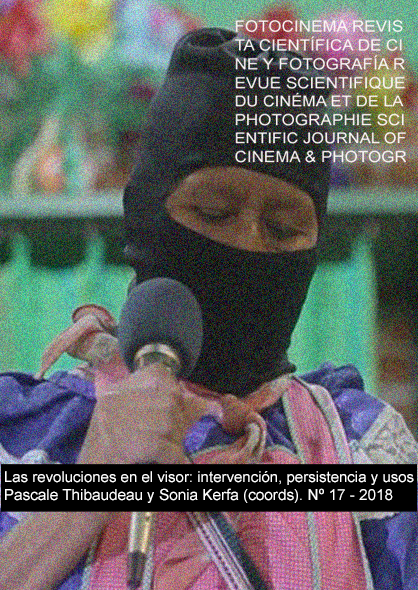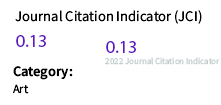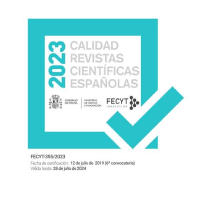The use of travelling as a mark of Wes Anderson's style: analysis of Rushmore (1998), The Royal Tenenbaums (2001) and The Grand Budapest Hotel (2014)
DOI:
https://doi.org/10.24310/Fotocinema.2018.v0i17.5116Keywords:
Travelling, author style, Wes Anderson, camera movements, cinemaAbstract
Wes Anderson is a film director recognized worldwide for the particular style he gives to each of his films. In this study we will analyze the importance of the use of travellings in the construction of this director's personal style, taking as an object of study three films from his extensive filmography, Rushmore (1998), The Royal Tenenbaums (2001) and The Grand Budapest Hotel (2014). To achieve this goal, we will make an analysis of the use of the travellings and their contribution to the development of the films stories. The results suggest that this camera movement is used by this American director to highlight the encounter that the protagonists have themselves and to give continuity to the story through the maturation suffered by them throughout the film.
Downloads
Metrics
References
Anderson, W. (1998). Rushmore. Estados Unidos: Touchstone Pictures.
Anderson, W. (2014). The Grand Budapest Hotel. Estados Unidos: American Empirical Pictures.
Anderson, W. (2001). The Royal Tenenbaums. Estados Unidos: Touchstone Pictures.
Aristóteles. (1974). Poética. Madrid, España: Gredos.
Arráez, R. M., y Pascual, C. (2014). La crisis de la postmodernidad: Análisis textual de los mundos sutiles de Chapero Jackson. Fotocinema. Revista Científica de Cine Y Fotografía, 8, 83–108. Recuperado de https://goo.gl/gb12ia
BBC.com. (2017). The 100 greatest comedies of all time. Recuperado de https://goo.gl/cMPAVB
BBC.com. (2016). The 21st Century's 100 greatest films. Recuperado de https://goo.gl/DrsKJ8
Bordwell, D. (1997). On the history of film style. Massachusetts, Estados Unidos: Harvard University Press.
Bordwell, D., & Thompson, K. (1995). El arte cinematográfico. España: Paidós Ibérica.
Bordwell, D., y Thompson, K. (2009). Film Art: An Introduction. New York, Estados Unidos: McGraw-Hill.
Boschi, E., y McNelis, T. (2012). “Same old song”: on audio-visual style in the films of Wes Anderson. New Review of Film and Television Studies, 10(1), 28–45. doi: 10.1080/17400309.2012.631174
Cortés-Selva, L. (2013). El sello del estilo visual de Dick Pope y Mike Leigh: análisis de su obra cinematográfica. Historia Y Comunicación Social, 18, 491–501. doi: 10.5209/rev_HICS.2013.v18.43983
Cortés-Selva, L., y Carmona-Martínez, M. M. (2016). El método de construcción del relato fílmico y el estilo cinematográfico de Mike Leigh: reflejo de una concepción ética y estética del mundo. ZER, Revista de Estudios de Comunicación, 21(40), 109–123. doi: 10.1387/zer.15513
Ferreras, J., y Vergilio, L. (2008). A vueltas con la alfabetización visual: lenguaje y significado en las películas de Wes Anderson. Revista Científica de Información y Comunicación, 5, 248–287. Recuperado de https://goo.gl/TtCk9F
Galindo, J. M. (2015). Del autor en la historia del cine. Revisiones y nuevas vías. Zer, Revista de Estudios de Comunicación, 20(39), 49–66. doi: 10.1387/zer.15517
Herzog, M. (2014). “Does This Seem Fake?”: Wes Anderson’s Kingdom of Visual Absurdity. Film Matters, 5(2), 66–67. doi: 10.1386/fm.5.2.66_1
IMDb.com. (2017). Academia Rushmore. Recuperado de https://goo.gl/r4Zrv
IMDb.com. (2017). El gran hotel Budapest. Recuperado de https://goo.gl/6CPZ4k
IMDb.com. (2017). Los Tenenbaums. Una familia de genios. Recuperado de https://goo.gl/2Uk6So
Jackson-Martín, R. (2015). Vértigo, de Alfred Hitchcock: voyeurismo y surrealidad visual. El Ojo Que Piensa, 6(11), 1–39. Recuperado de https://goo.gl/h4LJQ2
Koivumäki, M.-R. (2014). Poetic dramaturgy in Andrey Tarkovsky’s Nostalgia (1983): A character without a goal? Journal of Screenwriting, 5(1), 141–155. doi: 10.1386/josc.5.1.141
Koivumäki, M.-R. (2016). Dramaturgical Approach in Cinema-Elements of Poetic Dramaturgy in A. Tarkovsky’s Films. Helsinki, Finland: Aalto ARTS Books.
López, J. (2012). De cine. Cuadernos de Documentación Multimedia, 23, 107–114. doi: 10.5209/rev_CDMU.2012.v23.41127
Martínez, E., Sánchez, L., y Segura, R. (2012). Autor, discurso y poder. El cine de vanguardia. ICONO 14. Revista de Comunicación Y Nuevas Tecnologías, 1(10), 182–197. Recuperado de https://goo.gl/Xivosj
McKee, R. (2009). El guion. Barcelona, España: Alba minus.
Mercado, G. (2011). La visión del cineasta. Madrid, España: Anaya Multimedia.
Ráez, P. (2016). El cine de Wes Anderson: aspectos de composición visual y autoría (tesis de pregrado). Universidad de Lima, Lima, Perú. Recuperado de https://goo.gl/oPULTi
Roda, S. (2015). Edward Hopper: La cinematografía de lo pictórico. Revista Latente, 13, 81–100. Recuperado de https://goo.gl/WGJuz2
Rodríguez de Austria, A. M. (2015). Aristóteles en hollywood: poética y retórica en la narrativa audiovisual. Fotocinema. Revista Científica de Cine Y Fotografía, 11, 325–346. Recuperado de https://goo.gl/kmEvrg
Rodríguez, J. (2014). Construcción del espacio narrativo en el cine de John McTiernan: hacia el sello de autor. Revista de Comunicación de la SEECI, 17(35), 34–45. doi: 10.15198/seeci.2014.35.34-45
Rodríguez, J., Gonzálvez, J., y Caldevilla, D. (2016). El cine de acción de John McTiernan : autoría en la planificación y los movimientos de cámara. Revista de Ciencias Humanas y Sociales, 32(81), 12–26. Recuperado de https://goo.gl/WNKRCB
Seger, L. (1991). Cómo convertir un buen guion en un guion excelente. Madrid, España: Ediciones RIALP S.A.
Vreeland, A. V. (2015). Color Theory and Social Structure in the Films of Wes Anderson. Elon Journal of Undergraduate Research in Communications, 6(2), 35–44. Recuperado de https://goo.gl/EmsXri
Downloads
Additional Files
Published
How to Cite
Issue
Section
License
All contents published in Fotocinema Revista científica de cine y fotografía are protected under the Creative Commons Attribution-NonCommercial-ShareAlike 4.0 International (CC BY-NC-SA 4.0) license. All about this license is available in the following link: <http://creativecommons.org/licenses/by-nc-sa/4.0>
Users can copy, use, redistribute, share and exhibit publicly as long as:
- The original source and authorship of the material are cited (Journal, Publisher and URL of the work).
- It is not used for comercial purposes.
- The existence of the license and its especifications are mentioned.
There are two sets of authors’ rights: moral and property rights. Moral rights are perpetual prerogatives, unrenounceable, not-transferable, unalienable, imprescriptible and inembargable. According to authors’ rights legislation, Fotocinema. Revista científica de cine y fotografía recognizes and respects authors moral rights, as well as the ownership of property rights, which will be transferred to University of Malaga in open access. The property rights are referred to the benefits that are gained by the use or the dissemination of works. Fotocinema. Revista científica de cine y fotografía is published in an open access form and it is exclusively licenced by any means for doing or authorising distribution, dissemination, reproduction, , adaptation, translation or arrangement of works.
Authors are responsable for obtaining the necessary permission to use copyrighted images.










.png)

13.png)




